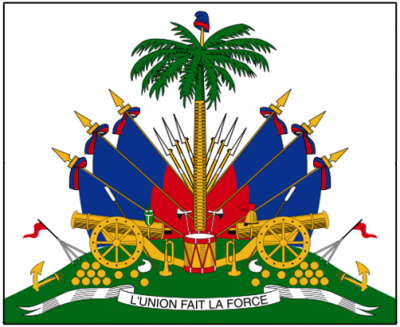The flag of Haiti is a bicolored flag with two horizontal stripes of blue and red and a white rectangle with the Haitian coat of arms in the center.
Flag of Haiti




The flag of Haiti is a bicolored flag with two horizontal stripes of blue and red and a white rectangle with the Haitian coat of arms in the center.

Haiti's coat of arms, which embodies the ideals of freedom and unity, depicts trophy weapons ready to defend the freedom of the people. At the top of the palm tree is a Phrygian cap, often called the cap of liberty, which has been used to symbolize freedom and the desire for freedom since the time of the Romans. Below the palm tree is the inscription: "L'Union Fait La Force" - "There is strength in unity".
France controlled the western third of Saint-Domingue from 1697 to February 1803. In 1793, Haiti's leader Toussaint Louverture adopted the French flag, and in 1801 he became the island's governor. But in June 1802, Louverture was captured by Napoleon Bonaparte and deported to France, where he died in prison. In 1803, Dessalines and Petion decided to stop fighting for the French and removed the white stripe from the French flag, creating the first Haitian flag. Dessalines also added the phrase Liberté ou la mort to the flag. Dessalines' relative, Catherine Flon, sewed together blue and red stripes to create a new Haitian flag. This flag symbolized the unification of blacks and mulattoes in the struggle for freedom.

On November 18, 1803, Haiti gained independence from France. In January 1804, the generals of the revolution changed the flag, making the stripes horizontal. It became a symbol of a free republic. A few months later, in May 1805, Haiti's new leader, Emperor Jacques I, adopted a new flag with vertical black and red stripes symbolizing death and freedom, respectively.

After the death of Jacques I in 1806, the country was divided into northern and southern regions, each with its own leader. In the South, Alexandre Petion returned to the flag of 1804 and added the inscription "L'union fait la force" - "Strength in unity" and the coat of arms of the Republic. This flag was used until 1964.
In December 1806, General Henri Christophe became president of the northern region of Haiti, and in 1811 he proclaimed himself king under the name Henri I. The kingdom used a flag with red and black vertical stripes and a crowned blue shield in the center, which depicts a phoenix under five five-pointed gold stars and the Latin inscription "Ex Cineribus Nascitur" - "From the ashes we will rise".
However, in 1818, the Kingdom of the North was defeated by President Petion, who introduced a new flag with horizontal blue and red stripes. Soon after, in 1822, President Boyer annexed the Spanish part of the island (the modern Dominican Republic), which declared its independence and joined Colombia. In this new republic, the flag of the Spanish Republic of Haiti was raised, but Boyer soon abolished it.

In 1844, an attempt to restore the black and red flag failed. In 1847, Faustin Suluc became president and proclaimed himself emperor under the name Faustin I. He kept the blue and red flag but changed the coat of arms to his own, symbolizing his monarchical power. After his death in 1859, the coat of arms of the Republic returned.
In 1957, François Duvalier became president, assuming full power in 1960. In 1963, a one-party system was established, and in 1964 a new constitution was adopted that restored the black and red flag. After Duvalier's death in 1971, his son Jean-Claude became president, but was overthrown by a popular uprising in 1986. On February 26, 1986, Haiti returned to the blue and red flag, which was officially approved in the 1987 constitution.
The flag of Haiti was first sewn on May 18, 1803 by Catherine Flon under the guidance of her godfather. On this day, parades are held throughout the country, people wear bright red and blue colors and paint their faces. Haitians love and are proud of their country, and the flag is a source of pride for Haitians around the world.